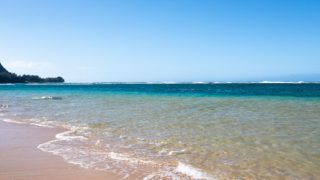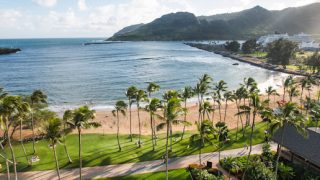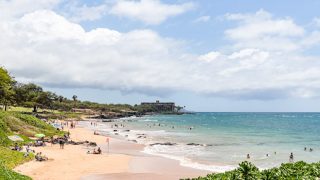Finding a parking spot near Kaanapali Beach felt like a game of musical chairs to us. The same cars circled the small public lot for twenty minutes under the mid-morning sun, each of us hoping someone would finally pull out. Every stall was either taken, coned off or reserved for resort guests. For a while, we wondered if we would even make it onto the sand at all. That everyday parking battle is now at the heart of a new debate that will shape how Maui, and perhaps all of Hawaii, shares its beaches with visitors.
Beginning in early 2026, the Park Maui pilot program will change how visitors and residents access some of the Valley Isle’s most popular beaches on weekends. It will start with Kihei beaches. The new law gives residents free parking and first priority before 10 a.m. on weekends and holidays.
Visitors will pay a flat $10 per day and can only park after 10 a.m. on those days. County officials say the change is meant to manage crowding and protect local beach access. For visitors, it is yet another rule to learn and another cost added to already expensive Hawaii vacations.
Hawaii’s beaches have long symbolized open access for everyone. But rising visitor numbers, limited infrastructure, and growing community pressure are forcing island counties to rethink how to balance tourism with residents’ quality of life. Maui’s new system is the latest test in that statewide struggle.
What the rules really mean.
The changes begin with the Kamaole I, II, and III beach parks in Kihei. These are some of Maui’s busiest beaches, filled every day by mid-morning with both residents and visitors. The new system will use a mobile app and on-site kiosks where drivers scan a Hawaii driver’s license to confirm residency. Parking attendants will assist users during an initial grace period before enforcement begins.
Bill 79 unanimously passed its first reading in August 2025 and is expected to move toward final approval later this year. The county says the full rollout will not happen until early 2026. That delay allows time for permits, testing, and kiosk installation. For now, South Maui beach lots remain free, though work is already underway to prepare for the transition to paid parking.
Visitors are already feeling the strain.
Our Kaanapali experience showed just how difficult parking has become. The small public lots near Whalers Village fill quickly, and resort garages can charge more than $40 a day. Travelers and residents (including us) report circling for long stretches, sometimes giving up and walking from distant streets or hotel lots.
Kaanapali may be a preview of what lies ahead in Kihei. Those beaches remain among the most accessible in Hawaii, yet the number of stalls has barely changed in decades. The new system will give residents an early window before visitors arrive, and that shift could change the feeling of a Maui beach day for everyone.
Why Maui says it needs this change.
Supporters of the new law argue that parking chaos has become unmanageable. Visitors often arrive even before sunrise to secure spots, sometimes blocking driveways or sidewalks. Residents say they cannot take their children to the beach on weekends because every space is gone before breakfast. Officials insist the new program will restore fairness and generate revenue for maintenance, restrooms, and lifeguards.
Critics say the plan could cause both confusion and frustration. Verifying residency through a scanned license may irritate visitors as well as part-time homeowners who split their time between islands and the mainland. Others question how consistently the county can enforce the rules given its staffing shortages.
Beyond Maui.
Parking problems are no longer limited to one island. On Kauai, the narrow road along Hanalei Bay and its small parking lots fill early most days, too. Poipu Beach Park parking is often packed by 9 a.m. On Oahu, parking at Ala Moana Beach Park can be challenging. Smaller Oahu beaches like Lanikai have long imposed parking restrictions to control crowds. Big Island also has its share of parking headaches at beaches like Kahaluu.
Each county is watching Maui’s experiment closely. If the residents-first parking system succeeds here, it could become a model for other islands. But if instead it breeds confusion or resentment, it could ignite a broader debate about how Hawaii balances preservation and access.
How to plan ahead.
For travelers heading to Maui in 2026, weekdays will remain the best time for beach visits. Resident-priority rules are scheduled to apply only on weekends and holidays, so weekday mornings should feel relatively unchanged.
Weekend visitors can plan to arrive after 10 a.m. or walk from nearby lodging if possible. Staying in Kihei or Wailea may make it easier to use hotel shuttles or ride shares instead of competing for stalls.
One Beat of Hawaii reader, Moshen, recently wrote that parking fees at Kamaole beaches “will drive visitors to beaches like nearby Keawakapu (with 60 spaces), which has no lifeguards and free parking.” That concern may prove true once Park Maui begins, as beachgoers seek out any remaining free lots.
A larger question for Hawaii visitors.
Beach parking has always been much more than a matter of convenience in Hawaii. It reflects who the beaches are for and how welcome people feel when visiting. Park Maui may bring order and revenue, but it also marks a turning point away from the open, easy access that defined Hawaii travel for more than half a century.
What’s your worst Hawaii beach parking story?
Get Breaking Hawaii Travel News







These fees are for County of Maui beach parking.
Earlier this year the Kapalua Beaches started charging a flat rate of $29 for parking.
I think the article is a little over dramatic about parking in Kihei near Kam 1,2,3. I’ve never had a problem finding parking or getting to the beach itself. Sure, an Kam 3 be busy at sunset? Sure, still park parking or street parking available. Kam 2 is usually busy because of Fred’s, not because of tourists specifically. Kam 1 already has small parking at the Guard station, but plenty of dirt lot parking next to ABC. So, not really buying the Kam congestion argument here.
Kamaole Beach Park II has no parking lot. Only Beach I and Beach III have parking.
Let’s not kid ourselves — this isn’t about “parking management.” It’s about the slow privatization of paradise.
Maui built its entire economy on tourists, then acts shocked when they show up. Now the fix is to charge $10 and make them wait until 10 a.m., as if that solves decades of bad planning and overdependence on tourism.
The article pretends to “balance both sides,” but it reeks of denial. Maui’s relationship with tourism is toxic — locals are over it, tourists feel unwanted, and the county’s big idea is… an app and a kiosk? Please.
This isn’t management — it’s theater. Hawaii can’t keep playing both roles: sacred homeland and global resort. The math doesn’t work. The soul doesn’t either.
Rent a scooter. jump the curb. Park in the grass. Park in the beach area. Skip the parking lot and $10 fee. See how Hawaii feels about that. No license scan required. Just wait until all the hotels and resorts raise their rates tremendously because they are the only locations in walking distance before 10am to the beach locations. Thanks Hawaii for putting tourist’s on the back burner again. IMO give the state what they want and just stop and I repeat stop going.
What does the person’s drivers license have to do with the residency? The vehicle is being parked not the resident. The vin or vehicle identifcation and proof of registration should be the standard and not the driver. If a non local wants to park does the out of state visitor want or prefer his/her drivers license scanned? NO. IMO the state has no business of the tourist’s drivers license information to just to park a car other than to send some citation. Please can I just borrow some homeless persons drivers license from Hawaii so I can park for free if this is the case. IMO just another thing that Hawaii adopts that clearly don’t make sense. Just another inconvenience or shut door situation that protrays how visitors are really not welcome.
Even though I own property and live here 6 months per year I guess I’m stuck paying the parking fee since I’m not a resident. Better to pay for parking than pay an income tax.
We just found required “scan to park” at Kapalua Bay and other parking areas. Along the Kapalua Beach Trail, a favorite place to walk. When we scanned the QR code, it said the total was $19! No option for a few hours. Needless to say, we chose not to park in any of the Kapalua beach access spots. $19 was way too much.
The Kapalua Bay beach parking and the Kapalua Coastsl Trail parking lots are a $29 flat rate when we went.
Maui: to do anything at all now requires both a smartphone app and a cash transfer from your bank to the Hawaii state government.
Total hard pass. Not paying it. Not doing it. Zero interest in this Disney pay-to-play theme park trash.
Attention lower 48: time to impose $300 per person tariffs on every flight from any Hawaiian island to the mainland. Also, forbid any Hawaiian resident from public street parking after 10:00 pm and before 10:00 am. Impound any car found in violation.
$10??!! 2026?? Why so late and so low?
Fees were implemented at the parking lots up in Kapalua in late 2024. $30 for non-residents, free for residents. We discovered the fee charge in December 2024, we were also there in March 2024 and no fees then.
We enjoyed driving up to Kapalua for sunrise walks along the path on Ironwood Cliffs. But didn’t go at all this year because of the crazy fee. We would be willing to pay a fee but not $30 for parking only 60-90 minutes.
It’s another crazy cash grab by Maui county.
Reading all these new fees and increases in the TAT makes me enjoy my trips to the Caribbean even more. Good luck Hawaii.
Does the new parking law charges apply to condo parking lots or just beach lots and street parking?
Oh the irony!
Maui just took $1,600,000,000 in US taxpayer wildfire aid.
Now, Maui is imposing timed restrictions on US citizen access to public beaches.
Outrageous greed and two-facedness.
I don’t disagree with residents having no fee to park but tourists paying $10. Where I Do see a problem is telling visitors they cannot even come to the beach until 10 am. Because mark my words here is what will happen. There will be a lot of empty parking spots not being used by residents and sitting there empty with a long line of tourists in rental cars sitting there waiting for that magic hour of 10 am getting angrier by the minute. And for that They get to pay $10 for the privilege.
Yup, and South Kihei Road is 1 lane in each direction in front of the Kams. Going to be some kind of show…
If you know these beaches, the 10 am thing makes sense. On weekends, especially Sundays, the locals come early (6-7 am) to set up for kids birthday parties and large family picnics. Especially at Kamaole III. I think there would be riots if they were no longer able to have such gatherings there.
As we were pulling out of our parking spot at Ho’okipa lookout, a man grabbed an orange traffic cone, and plunked it down in the spot we’d just vacated. With a sneer, he informed us that “I’m a local—I can do that.” And that perfectly symbolizes the attitude that has moved us to cross Maui off our travel list, permanently.
Terrible all the way around. They cannot deal with the real issue of lack of infrastructure and planning, so they set up expensive technology that is inconvenient for everyone (and judging from existing parking kiosks, will break down and cause further confusion). As a resident, I’m supposed to plan my day to get to the beach before 10 am – Oooh, it’s beach day, no sports in the morning today! Worse yet, as a visitor you’re supposed to go through that to go to the stinkin’ beach? You can’t go for sunrise? Why fly here?
And, probably not 1¢ will go towards maintaining current restrooms or building new restroom facilities or improving the parking lots.
It’s ironic that tourism is simultaneously Maui’s lifeblood and nemesis. I’ve watched Maui bite the hand that feeds it so deeply and so often that it seems we have no respect for the source of our livelihood. I don’t know if anyone will realize how hard we’ve been choking the golden goose before most of us lose our jobs and wind up in Las Vegas.
Nickel, dime, $10. Let’s throw a tax on everything. Maybe sunsets should be next. Maui has gone crazy sticking it to the lifeblood who keep it operating. We stay for the month of January, so now we should pay an extra $300 just to go to the beach. Enough already.
Well, this Goose will likely be making its last trip to Maui next month.
We have been coming to Maui (and the other islands) at least annually for the last 20 years.
Each successive trip over the last 8 to 10 years has found the Aloha spirit diminished from each previous trip.
It’s not just the higher costs, fees and taxes; not just the loss of Lahaina and the damaged Ka’anapali beach walk; not just the closure/destruction of favorite golf courses (Koele, Makena, Kahili, Kapalua); but it’s mainly the feeling that I’m not wanted or welcome.
It’s clear that billionaires like Larry Ellison, Mark Zuckerberg, Oprah Winfrey and Hawaiian politicians seem intent on turning Hawaii into a private playground for the super-wealthy with a peasant class to serve them. The middle and even upper-middle classes are being squeezed out.
There are many less expensive and more welcoming vacation destinations available.
Maui was a fabulous destination; it was fun while it lasted.
We have been coming to Maui for 25+ years. We love Maui and its people but when locals are pitted against visitors and vacation becomes an expensive chore the Aloha is gone! 🥲 I have one last trip planned for Maui next year and then I’m done. There are many beautiful places that will welcome me and my family. We are moving on.